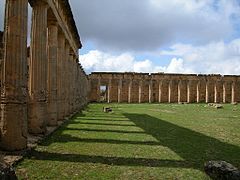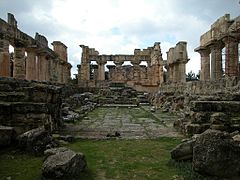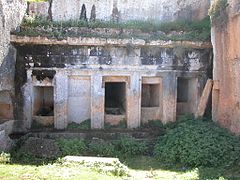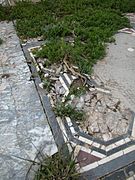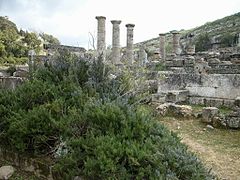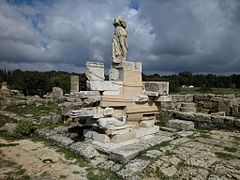Cyrene, Libya
Κυρήνη | |
Jebel Akhdar | |
| Coordinates | 32°49′30″N 21°51′29″E / 32.82500°N 21.85806°E |
|---|---|
| Type | Settlement |
| History | |
| Builder | Colonists from Thera led by Battus I |
| Founded | 631 BC |
| Abandoned | 7th century AD |
| Periods | Archaic Greece to Umayyad Caliphate |
| Site notes | |
Arab States | |
Cyrene, also sometimes
Cyrene lies on a ridge of the
The city was attributed to
Name
Cyrene is the
History
People have lived in Cyrenaica since the
Foundation
A
Archaeological evidence from the site, especially ceramic finds, confirm that Greek settlement began in the mid-seventh century BC. This early pottery derves from Thera, Sparta, and Samos, but also
Archaic period
After its foundation, the city was ruled by a series of monarchs descended from Battus I. Over the course of the sixth century BC, Cyrene grew to become the most powerful city in the region.[12] In the first half of the sixth century BC, Battus II encouraged further Greek settlement in the city, especially from the Peloponnese and Crete. This sparked conflict with the indigenous Libyans, whose king Adicran appealed to Egypt for help around 570 BC. The pharaoh Apries launched a military expedition against Cyrene, but was decisively defeated at the Battle of Irasa.[13][14][7]
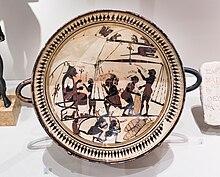
According to Herodotus, conflict with king
Battus III's son
Classical period

In the fifth century BC, perhaps as a consequence of the Persian intervention, Cyrene's influence over the other Greek cities in Cyrenaica seems to have solidified into institutionalised political control.
Towards the end of the fifth century BC, one Ariston took control of the city, put five hundred leading Cyreneans to death and exiled others. It is possible that he attempted to establish a radical
During the fourth century BC, Cyrene clashed with
Hellenistic period

In 324 BC, a Spartan mercenary leader,

Cyrene rebelled against Ptolemy again around 305 BC. Control was re-established in 300 BC by Ptolemy's step-son
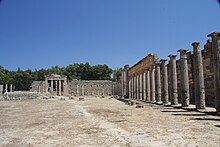
Cyrene was reduced to subject status, a garrison was installed, and a succession of Ptolemaic courtiers were appointed to the city's
The city became an important Jewish centre during the Hellenistic period. The deuterocanonical book 2 Maccabees, is said by its author to be an abridgment of a five-volume work by a Hellenized Jew by the name of Jason of Cyrene who lived around 100 BC.
Roman period
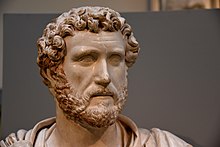
After 96 BC, the Romans initially ignored the new territory. Plutarch mentions a tyrant of Cyrene, Nicocrates, who was deposed by his wife Aretaphila of Cyrene and succeeded by his brother Learchus, who was murdered in turn.[43][44] Lucullus visited the city in 87 BC, suppressed the tyranny and granted Cyrene a new constitution.[44] But it was only in 74 BC that the Romans first sent a governor, Publius Cornelius Lentulus Marcellinus.[36] At some point between 67 and 30 BC, Cyrenaica became part of the Roman province of Crete and Cyrenaica. The provincial capital was on Crete, but Cyrene remained the chief city in Cyrenaica and enjoyed a highly prosperous period and much construction dates to the first century AD.[36] In the mid-first century AD, the Roman authorities launched an extensive surveying campaign to reclaim the public land around Cyrene that had slipped into private control and stopped paying dividends to the fisc.[45]
Because of its large Jewish population, Cyrene was an

A massive Jewish revolt, the
In the mid-third century AD, Cyrene's economy began to decline. This was hastened by an
Byzantine period
Another
The
Modern history
The site was totally abandoned in the early modern period. Frederick and Richard Beechey visited and produced the first site plans in 1821-1822. The French consul at Benghazi looted part of a tomb later in the century for the Louvre. The first systematic excavations were undertaken by Robert Murdoch Smith and E. A. Porcher between 1860 and 1861; their findings mostly went to the British Museum.[60][61] They include the Apollo of Cyrene and a unique bronze head of an African man.[62][63] The American Richard Norton began more scientific excavations in 1910, which were halted by the Italian invasion of Libya in 1911.[60] The tomb of the excavation's epigrapher, Herbert de Cou, who was shot in mysterious circumstances, is located on the site.[64]
The Italian colonial government established a military base at the site in 1913.[59] In the course of building the base, Italian soldiers found the "Venus of Cyrene", a headless marble statue representing the goddess Venus, a Roman copy of a Greek original, which prompted them to restrict their base to the Acropolis. The statue was transported to Rome, where it remained until 2008, when it was returned to Libya.[65] The village of Shahat grew up on the site as a result of the Italian presence.[59]
The Italians created an antiquities service and, after the discovery of the Venus of Cyrene, carried out excavations at Cyrene on a very large scale, which were closely connected with the regime's propaganda. The Italian archaeologists were expelled in 1943 when the Allies captured Cyrenaica.[60] Richard Goodchild, controller of antiquities from 1955 to 1966 moved the village of Shahat off the site and re-established it to the south; it has since expanded over much of the southern necropolis.[59] He also restored control of excavations at the site to the Italians, under Sandro Stucchi. Goodchild also The Italian mission has excavated much of the site and restored several buildings through the process of anastylosis.[66]
The site was declared a
In 2017 UNESCO added Cyrene to its List of World Heritage in Danger.[69]
Archaeological site
Cyrene is now an archaeological site north of the village of
Archaeological finds are stored and displayed in a temporary museum in the eastern portion of the site. In 2005, Italian archaeologists from the University of Urbino discovered 76 intact Roman statues at Cyrene from the 2nd century AD. The statues remained undiscovered for so long because "during the earthquake of 375 AD, a supporting wall of the temple fell on its side, burying all the statues. They remained hidden under stone, rubble and earth for 1,630 years. The other walls sheltered the statues, so we were able to recover all the pieces, even works that had been broken."[71]
Acropolis
Agora
House of Jason Magnus
Caesareum and Stoa of Hermes and Heracles
Caravanserai
Sanctuary of Apollo
One of its more significant features is the
Central Quarter
Temple of Zeus

The Temple of Zeus was the largest ancient Greek temple at Cyrene, and one of the largest Greek temples ever built. The original
East Church
Sanctuary of Demeter and Persephone
The sanctuary to Demeter and Persephone, which includes a
Necropolis

The necropolis consists of graves, rock-cut tombs, temple-tombs, and sarcophagi, dating from the sixth century BC until the fifth century AD. It covers about 20 km² to the south and north of the city, making it one of the largest known Greek necropoleis.[78] The southern section has been encroached upon by the growing city of Shahat, especially after 2013, when many tombs were bulldozed.[79] The northern portion is better preserved. Several of the tombs of the Roman period have niches for portrait busts of the deceased. A common find are statues of the so-called "Goddess of Death", a female bust - often faceless - depicted in the process of unveiling herself.[80]
Philosophy
Cyrene contributed to the intellectual life of the Greeks, through renowned philosophers and mathematicians. The School of Cyrene, known as the Cyrenaics, developed here as a minor Socratic school founded by Aristippus (perhaps the friend of Socrates, though according to some accounts a grandson of Aristippus with the same name). French Neo-Epicurean philosopher Michel Onfray has called Cyrene "a philosophical Atlantis" thanks to its huge importance in the birth and initial development of the ethics of pleasure.
Notable people
- Aretaphila of Cyrene, noblewoman
- Arete of Cyrene, philosopher
- Aristippus (c. 435 – c. 356 BC), philosopher and founder of the Cyrenaic School.
- Carneades, Academic skeptic philosopher
- Callicratidas, a general[81]
- Callimachus (310/305 – 240 BC), poet, critic, and scholar at the Library of Alexandria
- Cratisthenes of Cyrene, an Olympic winner at chariot-race. There was a statue of him at Olympia, created by Pythagoras[82]
- Eratosthenes (276 – 194 BC), mathematician, geographer, astronomer; librarian at the Library of Alexandria. First to calculate the circumference of the Earth.
- Eugammon (fl. 6th century BC), epic poet
- Idaeus of Cyrene, an ancient Olympic winner at foot-race. He won at 275 B.C.[83][84]
- Lacydes (3rd century BC), philosopher
- Philostephanus, Hellenistic writer
- Ptolemais, philosopher of music
- Simon of Cyrene, the man who helped carry the cross of Jesus
- Ptolemais
- Theodorus (c. 5th century BC), mathematician
- Theaetetus of Cyrene, poet
List of bishops
Known bishops of the town include[57][58][85][86]
- Saint Lukeby tradition
- Theodoro (fl. 302)
- Filo I (fl. 370 circa)
- Filo II (fl.370 circa)
- Rufo (fl.449)
- Leontius (fl.600 circa)
No longer a residential bishopric, Cyrene is today listed by the Catholic Church as a titular see.[87][88][89] The Greek Orthodox Church has also treated it as a titular see.[58]
Gallery
-
The Temple of Zeus
-
The Tomb of Battus
-
The Temple of Zeus
-
The Temple of Apollo
-
The Temple of Apollo
-
Agora Victory Monument
See also
- Cyrenaica
- Cyrenaics
- List of Kings of Cyrene
- Priest of Apollo (Cyrene)
- Extramural Sanctuary of Demeter and Persephone at Cyrene, Libya
References
- ^ "21 World Heritage Sites you have probably never heard of". Daily Telegraph. Archived from the original on 2015-12-03. Retrieved 2018-04-04.
- ^ a b c Kenrick 2013, p. 200.
- ^ Cambridge: Cambridge University Press, p. 247, n. 38.
- ^ "2957. Kuréné", Strong's Concordance.
- JSTOR 30103182.
- ^ OCLC 488610565.
- ^ a b c Rosamilia 2023, p. 19.
- ^ "Art and Craft in Archaic Sparta". Metropolitan Museum of Art. Retrieved 2021-10-16.
- ^ White, Domald (1975). "Archaic Cyrene and the Cult of Demeter and Persephone". Expedition Magazine. Vol. 17, no. 4. Penn Museum. Retrieved 2021-10-16.
- ^ a b Rosamilia 2023, p. 18.
- ^ Kenrick 2013, p. 156.
- ^ a b c d Rosamilia 2023, p. 21.
- ^ Clayton 2006, pp. 195–197.
- ^ Kenrick 2013, p. 2.
- ^ Kenrick 2013, p. 68.
- ^ a b Rosamilia 2023, p. 20.
- ^ a b c d Kenrick 2013, p. 3.
- ISBN 0-521-22804-2.
- ^ Kenrick 2013, p. 242.
- S2CID 84007922.
- ^ Kenrick 2013, p. 4.
- ^ Kenrick 2013, pp. 3 & 39.
- ^ a b Rosamilia 2023, p. 22.
- ^ Rosamilia 2023, p. 23.
- ^ Thucydides (1998). Strassler, Robert B. (ed.). The Peloponnesian War (The Landmark Thucydides ed.). New York: Touchstone. sec.7.50.
- ^ Rosamilia 2023, pp. 23–24.
- ^ a b c Rosamilia 2023, p. 25.
- ^ Dobias-Lalou, Catherine. "Account of Cyrene about grain supplies". Inscriptions of Greek Cyrenaica. Retrieved 2023-09-17.
- ^ a b c Rosamilia 2023, p. 26.
- ^ "Diagramma of Ptolemy I". Inscriptions of Greek Cyrenaica. Retrieved 2023-09-13.
- ^ Pfeiffer, Stefan: Griechische und lateinische Inschriften zum Ptolemäerreich und zur römischen Provinz Aegyptus. Münster: Lit, 2015, pp. 26–33.
- ^ ISBN 9780198861720.
- ^ a b c Rosamilia 2023, p. 27.
- ^ Bennett, Christopher. "Magas king of Cyrene". Egyptian Royal Genealogy. Retrieved 2023-09-13.
- ^ Bennett, Christopher. "Berenice II". Egyptian Royal Genealogy. Retrieved 2023-09-13.
- ^ a b c d Kenrick 2013, p. 5.
- ^ a b Rosamilia 2023, p. 28.
- ^ Grainger 2010, pp. 325 & 327.
- ^ Hölbl 2001, pp. 185–186.
- ^ a b c Rosamilia 2023, p. 29.
- ^ Kenrick 2013, p. 259.
- ^ "Will of Ptolemy VIII Euergetes II". Inscriptions of Greek Cyrenaica. Retrieved 2023-09-13.
- ^ Plutarch (1931). "Bravery of Women (Part 2 of 2)". De Mulierum Virtutibus. Loeb Classical Library edition, Plutarch. Vol. III. Retrieved 2008-02-14.
- ^ a b Rosamilia 2023, p. 30.
- ^ a b c d Kenrick 2013, p. 6.
- ^ Mark 15:21 and parallels
- ^ Acts 2.10, 11.20
- ^ Cassius Dio, lxviii. 32
- ^ a b c Kenrick 2013, p. 149.
- ^ Kenrick 2013, pp. 6 & 163.
- ^ a b c Kenrick 2013, p. 7.
- ^ Kenrick 2013, pp. 149 & 154.
- ISBN 978-88-209-7210-3)
- ^ Kenrick 2013, pp. 7 & 150.
- ^ Kenrick 2013, p. 8.
- ^ Kenrick 2013, pp. 150, 188, 225–226.
- ^ a b Michel Le Quien (1740). Oriens christianus in quatuor Patriarchatus digestus. Vol. II. Paris: Typographia Regia. pp. 621–624 – via Internet Archive. Via Google Books.
- ^ a b c Raymond Janin, v. Cyrène in Dictionnaire d'Histoire et de Géographie ecclésiastiques, vol. XIII, Paris 1956, coll. 1162–1164
- ^ a b c d Kenrick 2013, p. 151.
- ^ a b c Kenrick 2013, p. 15.
- ^ "Person/organisation: Sir Robert Murdoch Smith [Search for 'Robert Murdoch Smith']". British Museum Collection. Retrieved 2023-09-14.
- ^ "Colossal marble statue of Apollo". British Museum Highlights. Archived from the original on 2015-10-18. Retrieved 2016-07-22.
- ^ "Bronze portrait of a man". British Museum Highlights. Archived from the original on 2015-10-18. Retrieved 2016-07-22.
- ^ Kenrick 2013, p. 237.
- ^ Alessandro Chechi; Anne Laure Bandle; Marc-André Renold. "Case: Venus of Cyrene – Italy and Libya". Platform ArThemis. Art-Law Centre, University of Geneva. Archived from the original on 2013-12-13. Retrieved 2013-12-09.
- ^ Kenrick 2013, p. 16.
- ^ "Archaeological Site of Cyrene". UNESCO World Heritage Centre.
- ^ "Cyrene, Libya". Where We Work. Global Heritage Fund (GHF). Archived from the original on 2009-04-09. Retrieved 2009-04-27.
- ^ "Archaeological Site of Cyrene (Libya)". UNESCO. Archived from the original on 2017-10-22. Retrieved 2017-10-21.
- ^ Kenrick 2013, pp. 148–254.
- ^ "Interview with archaeologist Mario Luni". The Art Newspaper. Archived from the original on 2011-05-14. Retrieved 2009-05-22.
- ^ a b Kenrick 2013, p. 222.
- ^ Dinsmoor 1950, p. 86.
- ^ Goodchild, Reynolds & Herington 1958, p. 51-61.
- ^ Goodchild, Reynolds & Herington 1958, p. 39.
- ^ "Cyrenaica Archaeological Project". Cyrenacica.org. Archived from the original on 2013-01-21. Retrieved 2014-11-19.
- ^ "Mediterranean and Near Eastern Fieldwork at Penn". Sas.upenn.edu. Retrieved 2014-11-19.
- ^ Kenrick 2013, p. 235.
- ^ "Ancient Libyan Necropolis Bulldozed". Archaeology News Network. 2013. Archived from the original on 2017-10-21. Retrieved 2023-09-23.
- ^ Kenrick 2013, p. 238, 244-245.
- ^ Polyaenus, Strategems, 2.27.1
- ^ Pausanias, Description of Greece, Paus. 6.18.1
- ^ Perseus Encyclopedia, Idaeus
- ^ Pausanias, Description of Greece, 6.12.2
- ^ Pius Bonifacius Gams, Series episcoporum Ecclesiae Catholicae Archived 2015-06-26 at the Wayback Machine, (Leipzig, 1931), p. 462.
- Magonza, 1843).
- ISBN 978-88-209-9070-1), p. 870
- ^ "Titular Episcopal See of Cyrene Libya". GCatholic.org. Archived from the original on 2017-06-17. Retrieved 2023-09-14.
- ^ "Cyrene (Titular See) Cyrenaea". Catholic-Hierarchy. Archived from the original on 2017-06-25. Retrieved 2023-09-14.
Bibliography
- Asolati, Michele; Crisafulli, Cristina (2018). Cirene e la Cirenaica in età greca e romana. Roma: "L'Erma" di Bretschneider. ISBN 9788891317155.
- Cariddi, Lorenzo (2020). Cirene e l'acqua: ricerche e documenti sulla gestione delle risorse idriche in città e nella chora. Roma: "L'Erma" di Bretschneider. ISBN 9788891319623.
- Clayton, Peter A. (2006). Chronicles of the Pharaohs: the reign-by-reign record of the rulers and dynasties of ancient Egypt. Thames & Hudson. ISBN 0-500-28628-0.
- Dinsmoor, William Bell (1950). The Architecture of Ancient Greece: An Account of Its Historic Development. Biblo & Tannen Publishers.
- Goodchild, Richard George (1971). Kyrene und Apollonia (in German). Zurich: Raggi.
- Goodchild, R. G.; Reynolds, J. M.; Herington, C. J. (1958). "The Temple of Zeus at Cyrene". Papers of the British School at Rome. 26: 30–62. JSTOR 40310596.
- Grainger, John D. (2010). The Syrian Wars. ISBN 9789004180505.
- Hölbl, Günther (2001). A History of the Ptolemaic Empire. London & New York: Routledge. pp. 143–152 & 181–194. ISBN 0415201454.
- Kenrick, Philip (2013). Cyrenaica. Libya Archaeological Guides. Vol. 2. Silphium Press. ISBN 978-1-900971-14-0.
- Laronde, Andre (1987). Cyrène et la Libye hellénistique, Libykai Historiai : de l'époque républicaine au principat d'Auguste. Éditions du Centre National de la Recherche Scientifique.
- Luni, Mario (2014). La scoperta di Cirene: un secolo di scavi (1913-2013). Roma: "L'Erma" di Bretschneider. ISBN 9788891306425.
- Poli Fabrice, Vottéro Guy, De Cyrène à Catherine : trois mille ans de libyennes, Nancy, ADRA, 2005, 464p.
- Rosamilia, Emilio (2023). La città del silfio. Istituzioni, culti ed economia di Cirene classica ed ellenistica attraverso le fonti epigrafiche (in Italian). Pisa: Scuola Normale Superiore. ISBN 9788876427367.
- Rosenbaum, Elizabeth; Ward-Perkins, John (1980). Justinianic mosaic pavements in Cyrenaican Churches. Rome: Bretschneider. ISBN 9788891323729.
- Sachs, Gerd (2019). Alt-Thera und Kyrene – zwei verwandte griechische Städte. Mythos, Geschichte, Kultur. Antiquitates, vol 71. Hamburg: Verlag Dr. Kovač, ISBN 978-3-339-10636-0.
- Stucchi, Sandro (1976). Architettura cirenaica. Rome: Bretschneider. ISBN 887062448X.
- Thorn, James Copland (2005). The Necropolis of Cyrene: two hundred years of exploration. Roma: "L'Erma" di Bretschneider. ISBN 9788882653392.
- Excavation reports
- Stucchi, Sandro (1965). L'Agorà di Cirene. I: I lati nord ed est della platea inferiore (in Italian). L'Erma di Bretchneider. ISBN 9788870624472.
- Bacchielli, Lidiano (1981). L'Agorà di Cirene. II,1: L' area settentrionale del lato ovest della platea inferiore / F. Martelli. Roma: Bretschneider. ISBN 9788870625028.
- Purcaro, Valeria (2001). L'Agorà di Cirene. II,3: L' area meridionale del lato ovest dell'agorà / Valeria Purcaro. Roma: Bretschneider. ISBN 9788882651169.
- Bacchielli, Lidiano; Stucchi, Sandro (1983). L'Agorà di Cirene. II,4: Il lato sud della platea inferiore e il lato nord della terrazza superiore / Sandro Stucchi; Lidiano Bacchielli. Con contributi di G. Lepore. Roma: Bretschneider. ISBN 9788870625387.
- Ermeti, Anna Lia; Bacchielli, Lidiano (1981). L'Agorà di Cirene. III,1: Il monumento navale / Anna Lia Ermeti Allegati. Roma: "L'Erma" di Bretschneider. ISBN 9788870625035.
- Mingazzini, Paolino (1966). L'insula di Giasone Magno a Cirene. Rome: Bretschneider. ISBN 8870623742.
- Santucci, Anna; Micheli, Maria Elisa (2000). Il santuario delle nymphai chthoniai a Cirene: il sito e le terrecotte. Roma: "L'Erma" di Bretschneider. ISBN 9788882650759.
- Ghislanzoni, Ettore (1916). Gli scavi delle terme romane a Cirene (in Italian). Alfieri.
- Pernier, Luigi (1935). Il tempio e l'altare di Apollo a Cirene: scavi e studi dal 1925 al 1934 (in Italian). Istituto Italiano dÁrti Grafiche.
External links
- Cyrene project summary at Global Heritage Fund
- Explore Cyrene with Google Earth on Global Heritage Network
- Cyrene and the Cyrenaica by Jona Lendering
- University of Pennsylvania Museum excavations at Cyrene
- Dobias-Lalou, Catherine; Bencivenni, Alice; Berthelot, Hugues; Antolini, Simona; Marengo, Silvia Maria; Rosamilia, Emilio; Reynolds, Joyce; Roueché, Charlotte. "Home". Inscriptions of Greek Cyrenaica and Greek Verse Inscriptions of Cyrenaica. Retrieved 2023-09-14.
- Reynolds, Joyce; Roueché, Charlotte; Bodard, Gabriel; Dobias-Lalou, Catherine. "IRCyr. Inscriptions of Roman Cyrenaica". ircyr2020.inslib.kcl.ac.uk. Retrieved 2023-09-14.



